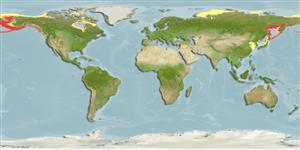Environment: milieu / climate zone / depth range / distribution range
Ecologia
marino demersale; distribuzione batimetrica 4 - 320 m (Ref. 50550). Temperate
Arctic: Chukchi Sea. North Pacific: Hokkaido, Japan and Sea of Okhotsk and to Buldir Island in the Aleutian chain.
Size / Peso / Age
Maturity: Lm ? range ? - ? cm
Max length : 45.0 cm FL maschio/sesso non determinato; (Ref. 115020)
Short description
Chiavi di identificazione | Morfologia | Morfometria
Spine dorsali (totale) : 11 - 13; Raggi dorsali molli (totale) : 19 - 20; Spine anali: 0; Raggi anali molli: 16 - 18. Scales on ventral scale row less than 1/2 the size of those on the dorsal scale row; fin membrane of spiny dorsal well incised; 4 preopercular spines; the 4th simple (Ref. 559).
Life cycle and mating behavior
Maturities | Riproduzione | Spawnings | Egg(s) | Fecundities | Larve
Masuda, H., K. Amaoka, C. Araga, T. Uyeno and T. Yoshino, 1984. The fishes of the Japanese Archipelago. Vol. 1. Tokai University Press, Tokyo, Japan. 437 p. (text). (Ref. 559)
IUCN Red List Status (Ref. 130435)
Threat to humans
Harmless
Human uses
Strumenti
Special reports
Download XML
Fonti Internet
Estimates based on models
Preferred temperature (Ref.
123201): -1.3 - 5.3, mean 0.9 °C (based on 783 cells).
Phylogenetic diversity index (Ref.
82804): PD
50 = 0.5156 [Uniqueness, from 0.5 = low to 2.0 = high].
Bayesian length-weight: a=0.00617 (0.00328 - 0.01160), b=3.11 (2.94 - 3.28), in cm total length, based on LWR estimates for this species & (Sub)family-body (Ref.
93245).
Trophic level (Ref.
69278): 3.5 ±0.54 se; based on food items.
Resilienza (Ref.
120179): Molto basso, tempo minimo di raddoppiamento della popolazione più di 14 anni (Preliminary K or Fecundity.).
Fishing Vulnerability (Ref.
59153): Moderate vulnerability (40 of 100).
